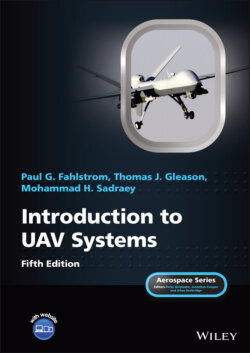Читать книгу Introduction to UAV Systems - Mohammad H. Sadraey - Страница 75
3.8 Induced Drag
ОглавлениеDrag of the three‐dimensional airplane wing plays a particularly important role in airplane design because of the influence of drag on performance and its relationship to the size and shape of the wing planform.
The most important element of drag introduced by a wing – at high angles of attack – is the “induced drag,” which is drag that is inseparably related to the lift provided by the wing. For this reason, the source of induced drag and the derivation of an equation that relates its magnitude to the lift of the wing will be described in some detail, although only in its simplest form.
The lowest induced drag is generated when the lift distribution over the wing is elliptical (Figure 3.14), which provides a constant downwash along the span, as shown in Figure 3.14. Aerodynamicists in the past – including Ludwig Prandtl – believed that a wing whose planform is elliptical would have an elliptical lift distribution. But further research has not proven this idea. The notion of a constant downwash velocity (w) along the span will be the starting point for the development of the effect of three‐dimensional drag.
Considering the geometry of the flow with downwash, as shown in Figure 3.15, it can be seen that the downward velocity component for the airflow over the wing (w) results in a local “relative wind” flow that is deflected downward. This is shown at the bottom, where w is added to the velocity of the air mass passing over the wing (V) to determine the effective local relative wind (Veff) over the wing. Therefore, the wing “sees” an angle of attack that is less than it would have had there been no downwash.
Figure 3.14 Elliptical lift distribution
Figure 3.15 Induced drag diagram
The lift (L) is perpendicular to V and the net force on the wing is perpendicular to Veff. The difference between these two vectors, which is parallel to the velocity of the wing through the air mass, but opposed to it in direction, is the induced drag (Di). This reduction in the angle of attack is
(3.8)
Then, the induced drag coefficient (CDi) is given by
(3.9)
This expression reveals to us that air vehicles with short stubby wings (small AR) will have relatively high‐induced drag and therefore suffer in range and endurance. Air vehicles that are required to stay aloft for long periods of time and/or have limited power, as, for instance, most electric‐motor‐driven UAVs, will have long (high AR) thin wings.
